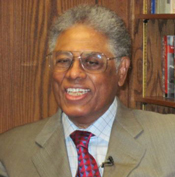redo Jump to...
print Print...
 (by Thomas Sowell, RealClearPolitics) – Most people are not even surprised any more when they hear about someone who came here from Korea or Vietnam with very little money, and very little knowledge of English, who nevertheless persevered and rose in American society. Nor are we surprised when their children excel in school and go on to professional careers.
(by Thomas Sowell, RealClearPolitics) – Most people are not even surprised any more when they hear about someone who came here from Korea or Vietnam with very little money, and very little knowledge of English, who nevertheless persevered and rose in American society. Nor are we surprised when their children excel in school and go on to professional careers.
Yet, in utter disregard of such plain facts, so-called “social scientists” do studies which conclude that America is no longer a land of opportunity, and that upward mobility is a “myth.” Even when these studies have lots of numbers in tables and equations that mimic the appearance of science, too often their conclusions depend on wholly arbitrary [random] assumptions.
Even people regarded as serious academic scholars often measure social mobility by how many people from families in the lower part of the income distribution end up in higher income brackets. But social mobility — the opportunity to move up — cannot be measured solely by how much movement takes place.
Opportunity is just one factor in economic advancement. How well a given individual or group takes advantage of existing opportunities is another. Only by implicitly [absolutely] (and arbitrarily) assuming that a failure to rise must be due to society’s barriers can we say that American society no longer has opportunity for upward social mobility.
The very same attitudes and behavior that landed a father in a lower income bracket can land the son in that same bracket. But someone with a different set of attitudes and behavior may rise dramatically in the same society. Sometimes even a member of the same family may rise while a sibling stagnates or falls by the wayside.
Ironically, many of the very people who are promoting the idea that the “unfairness” of American society is the reason why some individuals and groups are not advancing are themselves a big part of the reason for the stagnation that occurs.
The welfare state promoted by those who insist that it is society that is keeping some people down makes it unnecessary for many low-income people to exert themselves — and therefore makes it unnecessary for them to develop their own potential to the fullest.
The multiculturalist dogma that says one culture is just as good as another paints people into the cultural corner where they happened to have been born, even if other cultures around them have features that offer better prospects of rising.
Just speaking standard English in an English-speaking country can improve the odds of rising. But multiculturalists’ celebration of foreign languages or ethnic dialects, and of counterproductive cultural patterns exemplified by such things as gangsta rap, can promote the very social stagnation that they blame on “society.”
Meanwhile, Asian immigrants or refugees who arrive here are not handicapped or distracted by a counterproductive social vision full of envy, resentment and paranoia, and so can rise in the very same society where opportunity is said to be absent.
Those “social scientists,” journalists and others who are committed to the theory that social barriers keep people down often cite statistics showing that the top income brackets receive a disproportionate and growing share of the country’s income.
But the very opposite conclusion arises in studies that follow actual flesh-and-blood individuals over time, most of whom move up across the various income brackets with the passing years. Most working Americans who were initially in the bottom 20 percent of income-earners, rise out of that bottom 20 percent. More of them end up in the top 20 percent than remain in the bottom 20 percent.
People who were initially in the bottom 20 percent in income have had the highest rate of increase in their incomes, while those who were initially in the top 20 percent have had the lowest. This is the direct opposite of the pattern found when following income brackets over time, rather than following individual people.
Most of the media publicize what is happening to the statistical brackets — especially that “top one percent” — rather than what is happening to individual people.
We should be concerned with the economic fate of flesh-and-blood human beings, not waxing indignant [becoming increasingly outraged] over the fate of abstract statistical brackets. Unless, of course, we are hustling for an expansion of the welfare state.
Thomas Sowell is a senior fellow at the Hoover Institution, Stanford University and the author of “Basic Economics,” ”Applied Economics” and “The Housing Boom and Bust.” Over the past three decades, Dr. Sowell has taught economics at various colleges and universities, including Cornell, Amherst, and the University of California at Los Angeles.
Coypright 2013 Creators.com. Published March 6, 2013 at RealClearPolitics.com. Reprinted here on March 14, 2013, for educational purposes only. May not be reproduced on other websites without permission from RealClearPolitics and Creators.
Questions
1. What is the main idea of Thomas Sowell’s commentary?
2. a) Which of Dr. Sowell’s statements about economic mobility are new ideas to you?
b) For each one, do you think Dr. Sowell’s assertion is reasonable? Explain your answers.
- “The very same attitudes and behavior that landed a father in a lower income bracket can land the son in that same bracket. But someone with a different set of attitudes and behavior may rise dramatically in the same society. Sometimes even a member of the same family may rise while a sibling stagnates or falls by the wayside.” (from para. 5)
- “Just speaking standard English in an English-speaking country can improve the odds of rising. But multiculturalists’ celebration of foreign languages or ethnic dialects, and of counterproductive cultural patterns exemplified by such things as gangsta rap, can promote the very social stagnation that they blame on ‘society.'” (from para. 9)
- “Meanwhile, Asian immigrants or refugees who arrive here are not handicapped or distracted by a counterproductive social vision full of envy, resentment and paranoia, and so can rise in the very same society where opportunity is said to be absent.” (from para. 10)
- “Most working Americans who were initially in the bottom 20 percent of income-earners, rise out of that bottom 20 percent. More of them end up in the top 20 percent than remain in the bottom 20 percent.” (from para. 12)

